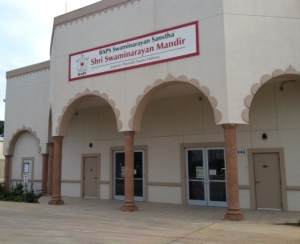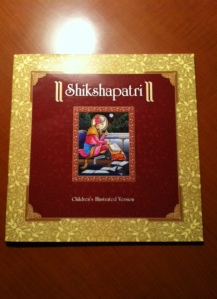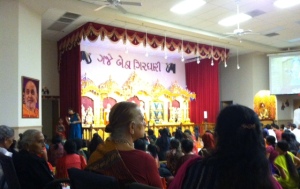 Sunday #41 – BAPS Shri Swaminarayan Mandir, (Hindu Temple) San Antonio, TX
Sunday #41 – BAPS Shri Swaminarayan Mandir, (Hindu Temple) San Antonio, TX
Why this temple?
Not knowing a single Hindu person in San Antonio, I reached back out to my Muslim friend Nazneen who was born in India. She graciously got in touch with people she knew and found a Hindu Temple where we could both learn more about Hindu religious practices and beliefs.
My head swam with all the different names used; I’ve never seen so many consonants and vowels used in one language; the long names made it difficult for me to follow everything, so I just tried to soak in as much as I could. Much of what I relay in this blog has no structure and remains just the bits and pieces I picked up on Sunday afternoon at the temple. Most of the tidbits are random and maybe just of interest to me. This visit definitely warrants another trip so I can hopefully become more familiar with all the various words and meanings.
My preconceived ideas of Hindus
Before my visit, I expected the following:
• Colorful saris or sarees (not sure which is the correct pluralization of that word)
• Lots of incense
• Smell of curry – it’s one of those spices that’s a lot like cigarette smoke – when used, it penetrates your clothing, home and your complete essence. I rarely use curry when I cook; sometimes I like it, but most of the time I don’t.
• Indians seemed to be the most adept at sitting on the ground and completely comfortable in doing so. I expect to see a lot of sitting.
Yep, that’s about it. I’m afraid I’m Hindu ignorant, so I looked forward to learning more. Below, you’ll find a beginner’s crude understanding of this Hindu sect, so please forgive all the mistakes I’m about to make in referencing various aspects to which I don’t have a full understanding.
Arrival
I pulled into an iron gate that surrounds the mandir (their word for “temple”) that sits conspicuously along Hwy 1604 North. Odd how you can drive by a building over and over again and never see it, until you look for it. I parked in the first spot I found and waited for Nazneen to arrive. Several young boys played hoops on a court next to my loaner Mercedes (Smart Car was in the shop). By the time the basketball hit the car for a second time, I knew it was time to move this loaner vehicle. Once in my second parking spot, far, far away from the court, I texted Nazneen who was already inside and headed through the front doors.
We met her friend, who greeted me with hands in a prayer position and gave an ever so slight bow. I would learn later that this Hindu sect often bows down to touch the feet of elders in hopes of receiving blessings. I seemed to be younger than this woman, so thankfully she didn’t greet me in this way; I would not have known what to do and would have been so embarrassed by the paint stains on my feet from painting a room earlier in the day. (No shoes worn in Hindu Temples or Mosques).
Nazneen’s friend gave us a quick overview of what goes on at different times during Sunday. We learned that we missed a 4:30 service and that a service would be happening at 6:00 or 6:30 but it would be in the native language of Gujarti – an easy thing to follow for Nazneen because that’s her native language; for me – not so much. I don’t know one word of Gujarti, though I have heard Nazneen say “Neigh” for “no.” My one learned Gujarti word.
We thought we might be attending a Diwali event. Diwali is an ancient Hindu festival celebrated in the fall. It signifies the victory of light over darkness, knowledge over ignorance and good over evil. From what I gather, it’s sort of a cross between what American’s celebrate in Christmas and New Year’s combined. However, Diwali was later in that week.
At one point, Nazneen’s friend went to the small book shop area and grabbed a children’s book called Sikshapatri and gave it to me to keep; it’s the shortened and English children’s version of what Bhagwan Swaminarayan (1781-1830 CE) wrote to help devotees and sadhus lead virtuous lives. I promptly read it when I returned home and found the principles taught to be worthy of praise. I especially like the one that instructs: “Never perform a task immediately without thinking.”
After answering a few more questions, we were led into a room where we could deposit our shoes and then were ushered to a back room where the young adults, teens and younger children had broken into groups and were discussing life lessons in English.
Hindu Version of Sunday School
I wish I could tell you what this portion of the meetings were called, but I’ve spaced on that. However, Nazneen and I both found the young adults to be delightful and most helpful in aiding our understanding of their customs and beliefs.
Nazneen wanted to know more about the bindi (red dot you see on the foreheads of many Hindu women). We learned that the name represents “small dot or dab” and signifies the sixth chakra. As Hindu women say their prayers in the morning, this is applied to help them remember the wisdom from the highest spiritual place.
We then talked a lot about dating – not allowed with Hindus and quite similar to the practices of most Muslims. Education is valued highly by the Hindus, so girls typically don’t even think about marriage until after they have finished their bachelor degrees. Men and women worship separately in Hindu temples and dating is just not a part of their culture. Once a woman decides she is ready for marriage, she tells family and friends and the word is spread. The women we spoke with say it’s now less of an arranged marriage and more like arranged introductions.
When we were introduced to the young women, who were all related (daughters and daughter-in-laws) to the woman whom we first met, we were told they had moved to the states from South Africa. Not knowing that there was a large body of Hindus in South Africa, I wanted to know more. I learned that indeed, the British took Indians to that area of the world to work the mines and in other industries. Knowing a bit (very little bit) about apartheid, I asked if the Indians were considered black or white. They explained that they were considered brown, so they were lumped in with the black population and were discriminated against. I immediately wanted to know what they thought of Nelson Mandela. I expected glowing praise, but that’s not what I received. One of the young women was kind enough to share her feelings about the progress that has been made since that time. It’s really too long to share, but I found her perspective fascinating.
I also learned that poojas (prayers) are said several times a day and like Muslims, they are instructive to say their first poojas before sunrise. Of course my comment was, “Well, that settles the whole sleeping in till 10:00am problem with teens!”
One of the most interesting topics we moved into was the subject of reincarnation. The young women wanted to know my views on reincarnation, which I shared, then I learned that Hindus believe that we go through 1.8 billion lives before we get to have a human experience. Boy, do I feel old now!
Service Begins
After the “Hindu Sunday School” – again, I can’t remember what Hindus call it, we moved into the main worship area. Nazneen walked me past the women sitting cross-legged on the floor and showed me to some chairs lined on the side of the room where mostly older people sat. Did I get upset by this obvious indication of my advanced years? NO. I was so glad that I wouldn’t have to sit cross-legged for a long time and would have more of a birds-eye view of what was to transpire.
We walked in while a band sat crossed legged on the stage. Can’t tell you what kind of instruments they used. At that point, I noted the 1½ foot wall that ran down the middle of the room leading to the Hindu altar. Men sat in chairs on one side and women sat crossed legged on the floor across from them. After the music, the men who sat in some chairs moved those to the back, then sat on the floor while facing the Hindu altar that was surrounded by heavy curtains, donned in lights and consisting of several statues.
At that point, Nazneen left her seat on the floor and came to ask if I’d like to participate in what was to happen after the singing. I’d been told that this portion of the service was called circumlocution, or something like that. Candles that are in round clay trays are moved counterclockwise as they chant.
Then these clay trays were passed to the front and a couple of women passed around a candle. As it came to each person, he or she would place his or her hands over the flame then bring their hands over the top of the head and then to their heart. I even got to do this, but I had no idea what I was doing.
Clueless!
Then the lights were turned on and I watched as the women stayed seated and the men began doing their prostrations. It appeared to me that once they laid down on the floor, they would extend their arms out in front of them and then move their head from left side to right side and then do that all over again. Then, as quick as it started, it was all over.
Post Thoughts
Two expectations were quickly dispelled after the visit. I smelled no curry and no incense. In fact, I smelled more incense at the St. Sophia’s Greek Orthodox church than this Hindu Temple, and I didn’t smell any curry at all. But this temple does have a separate area for food cooked by the Indian people who attend this temple. I had a wonderful time just going through all the different food stuffs that were so unfamiliar to me.
All in all, I enjoyed my visit to this Hindu temple. I met some great, peaceful people and although the names that are bandied about are so unfamiliar, if you have someone to coach you along the way, it will help. I believe you might also find helpful people in any Hindu temple you might happen upon, so check it out. You’ll either learn something or like me, have your brain short circuited by learning too much at one time!
What’s Next?
Didn’t make it to Joel Osteen’s church last weekend, so I’ll have to hit two services this weekend. One will definitely be the Spanish mission church. I’m not putting that one off, but things keep getting in the way. Not sure about the other selection just yet. Not too many left to attend. One person at the Hindu Temple recommended checking out Jainism. That’s a form of Hinduism where they treasure all life to such a great degree that they cover their mouth, so as not to swallow any insects and thus kill them. Hmmm……I keep wondering how they might deal with termites?


Please do attend the Annakut celebrations on Nov. 2nd. Details in flyer.
Thanks, Julie. Can you tell everyone a bit more about the Annakut celebrations?
Marcia
I’m certainly not an authority but “Annakut” translates to a mountain or heap of food (some background at http://www.swaminarayan.org/festivals/diwali/index2.htm). It is really something amazing to see. Over a hundred plus food dishes/items will be neatly arranged and offered to celebrate the Hindu New Year’s which was on October 24th this year (observed on November 2nd this year at the San Antonio BAPS Swaminarayan Mandir). Some mandirs/temples have over a thousand dishes. You can see some photos here http://www.baps.org/News/2014/Diwali–Annakut-Celebration-2014-6909.aspx
Hope to see you there!
Julie,
I would have loved to have gone. That sounded like such fun and something unique to experience. I’ll certainly try to make it in 2015.
[…] means either. I began to feel that worshiping in a Jewish service is much like worshiping at the Baps Shri Swaminarayan Mandir – Hebrew words and saying made about as much sense to me as did Hindu. Then we had another […]